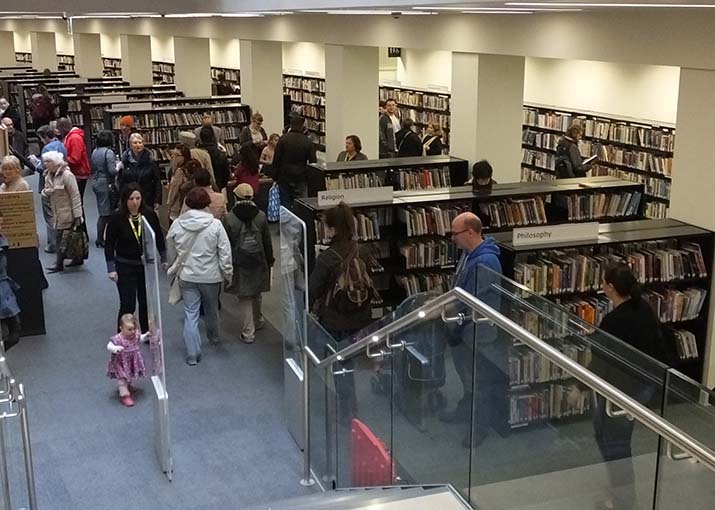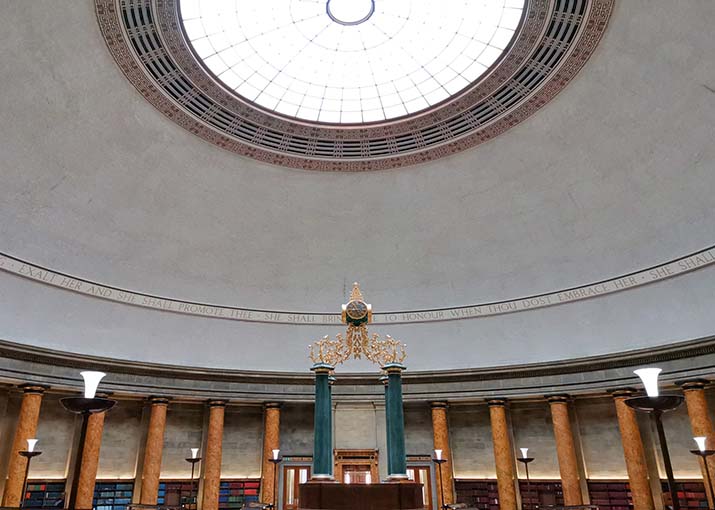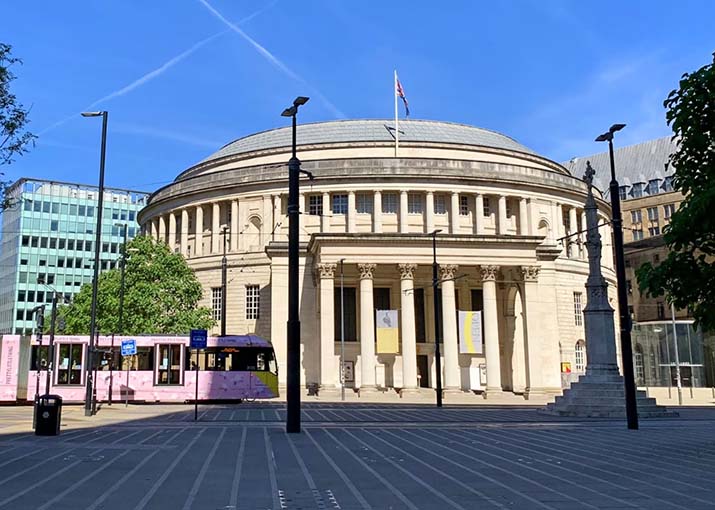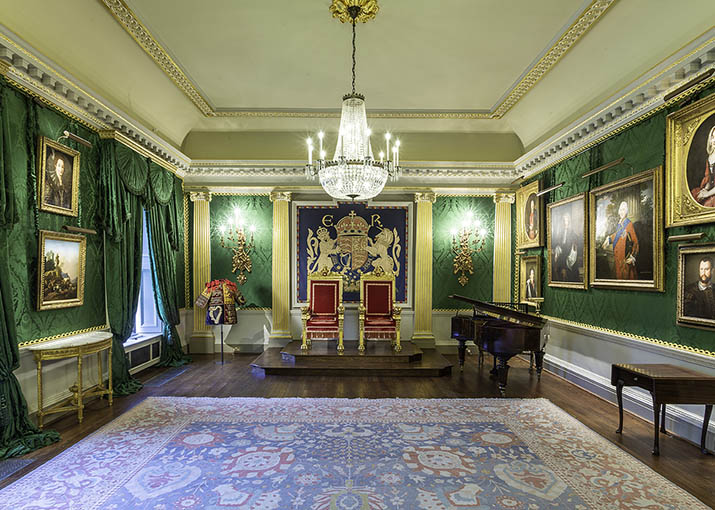My recent adventure brought me to the heart of Manchester, where I embarked on a fascinating journey through the Manchester Central Library. Nestled in the vibrant St Peter’s Square, this architectural marvel proved to be more than just a sanctuary of books—it unfolded as a cultural trove waiting to be explored.
The grandeur of St Peter’s Square unfolded before me as I approached the Manchester Central Library, its imposing structure standing as a testament to the city’s rich cultural heritage. The allure of the library was undeniable, beckoning me to venture beyond its doors and explore the treasures within.
Arrival at St Peter’s Square: A Glimpse into Manchester’s Architectural Splendor
My exploration began as I set foot on St Peter’s Square, a charming civic space adorned with the grace of Manchester’s architectural heritage. The commanding facade of the Manchester Central Library, featuring Corinthian columns and a neoclassical design, served as an enticing gateway to the intellectual wonders that lay within.
Entering the Literary Haven: A Harmonious Fusion of Books and Architecture
As I ventured further into the library, the hushed whispers of pages turning and the subtle creaking of ancient shelves echoed in the air. The scent of aged paper and leather-bound books permeated the atmosphere, evoking a sense of reverence for the accumulated wisdom that surrounded me.
The shelves, towering like sentinels of knowledge, held an eclectic array of books spanning centuries and genres. Antique tomes with weathered spines stood alongside modern works, creating a harmonious convergence of the past and present. Each section of the library seemed to be a portal to a different era, beckoning me to explore and discover the treasures hidden within.
I followed the meandering pathways, my fingertips lightly grazing the spines of books as I went. Sunlight filtered through stained glass windows, casting a warm and ethereal glow upon the rows of knowledge. The silence within the library was punctuated only by the occasional creaking of wooden floors beneath my footsteps, creating a symphony of serenity.
As I delved deeper, I encountered secluded alcoves adorned with plush chairs and dim reading lamps, inviting patrons to lose themselves in the enchanting worlds crafted by words. Each corner held the promise of a unique literary adventure, whether through the annals of history, the corridors of fiction, or the realms of scientific inquiry.
The library was not just a repository of books; it was a sanctuary for the curious, a haven for those seeking solace in the written word. The collective wisdom housed within these walls seemed to transcend time, offering a timeless refuge for minds eager to explore, learn, and dream.
Lost in the labyrinth of knowledge, I marveled at the convergence of architecture and intellect. The design of the library mirrored the synthesis of classical aesthetics and contemporary sensibilities, a testament to the enduring power of human creativity. Each step through the corridors felt like a journey through epochs, a pilgrimage through the collective consciousness of humanity.
As I continued my exploration, I couldn’t help but feel a profound sense of gratitude for the architects of this bibliophilic haven. Their vision had brought forth a space where the past whispered to the present, where ideas flowed seamlessly from one generation to the next. In this sacred space, I realized that the library was not merely a structure; it was a bridge connecting minds across time and space, an embodiment of the endless pursuit of knowledge that defines the human spirit.
Navigating the Collections: Literary Exploration at Its Pinnacle

The labyrinthine stacks of the Manchester Central Library unfolded before me like a literary maze, each aisle leading to new realms of knowledge. The sheer diversity of the collection was awe-inspiring, reflecting a commitment to encompassing the entire spectrum of human curiosity.
In one section, the classics stood tall, their spines bearing the weight of literary history. Works from Shakespeare to Austen lined the shelves, inviting readers to lose themselves in the timeless tales woven by the masters of words. The faint scent of aged paper and leather seemed to intensify as I ventured further, creating an atmosphere that transported me through the centuries.
As I turned a corner, the landscape transformed into a vibrant panorama of modern thought. Here, the latest works on science, technology, and innovation shared shelf space with explorations of contemporary culture and social commentary. It was a testament to the library’s commitment to staying at the forefront of knowledge, bridging the gap between tradition and the cutting edge.
The multimedia section, with its rows of computers, audiovisual materials, and interactive displays, added a dynamic dimension to the library experience. Patrons were engaged in exploration, whether immersed in virtual reality, delving into the latest research, or participating in workshops that bridged the gap between the analog and digital worlds.
Periodicals whispered their stories from neatly organized racks, offering a snapshot of the world’s ever-evolving narratives. Magazines and journals covered an array of subjects, from art and science to politics and philosophy. The library, it seemed, was not just a repository of static knowledge but a living organism, adapting to the pulse of contemporary thought.
In quiet corners, cozy reading nooks beckoned, inviting visitors to linger with a book or a tablet, creating a space for contemplation and introspection. The ambiance was both invigorating and serene, fostering an environment where minds could expand and ideas could flourish.
The Manchester Central Library was more than a building; it was a vibrant ecosystem of ideas, a crossroads where past met present and tradition met innovation. It embraced the collective curiosity of its patrons, offering a haven for those who sought to explore the vast landscapes of human knowledge. As I continued to wander through the stacks, I marveled at the tapestry of intellect woven into the very fabric of the library—a testament to the enduring power of the written word and the boundless curiosity of the human mind.
Special Collections and Archives: Unveiling Manchester’s Historical Tapestry
The entrance to the Special Collections and Archives beckoned like a gateway to a secret realm, hidden within the heart of the library. As I stepped through, the air seemed to change, carrying with it the weight of centuries past. The subdued lighting accentuated the solemnity of the space, creating an ambiance that demanded reverence for the historical artifacts it cradled.
The first artifact that caught my eye was a meticulously preserved manuscript, its vellum pages adorned with calligraphy that danced across the parchment. It chronicled the tales of Manchester’s earliest days, its inked narrative weaving a tapestry of struggles, triumphs, and the steady march of progress. Beside it, an ancient map unfolded a visual narrative, charting the changing landscape of the city through the ages.
The shelves, lined with leather-bound volumes and archival boxes, held the echoes of Manchester’s collective memory. Delicate letters exchanged between prominent figures, faded photographs capturing moments frozen in time, and official documents bearing the weight of historical decisions—all meticulously cataloged and preserved.

As I perused the archives, I stumbled upon a collection of newspapers, their yellowed pages chronicling events that had shaped the destiny of the city. Headlines screamed of industrial revolutions, political upheavals, and the resilient spirit of its people. These artifacts were not just records; they were living testaments to the ebb and flow of life in Manchester.
In a corner, I discovered a room dedicated to oral histories, where recorded interviews immortalized the voices of those who had witnessed the city’s transformation firsthand. Their anecdotes and recollections breathed life into the pages of history, turning the past into a vivid, immersive experience.
Time seemed to dissolve as I immersed myself in the archives, connecting with the stories etched on parchment, photographs, and audio recordings. The preservation efforts undertaken by the custodians of these collections were nothing short of a labor of love—a commitment to ensuring that the essence of Manchester’s history endured for generations to come.
Leaving the Special Collections and Archives, I felt a profound sense of gratitude for the guardians of these historical treasures. The journey through Manchester’s past had not only enriched my understanding of the city but had also instilled a deep appreciation for the importance of preserving and cherishing the stories that define us. As I stepped back into the main library, I carried with me not just the knowledge of books but the living, breathing history that resided within the sacred halls of the Special Collections and Archives.
Cafe and Reading Spaces: Moments of Contemplation
Within the vast expanse of books, the library offered serene reading corners and a cafe overlooking St Peter’s Square. These tranquil spaces provided moments for reflection, allowing visitors to absorb the knowledge they had uncovered or simply savor a cup of coffee while immersing themselves in the intellectual ambiance.
A Cultural Odyssey at Manchester Central Library
My expedition through Manchester Central Library transcended a mere literary exploration—it evolved into a cultural odyssey through the epochs of human knowledge. The library’s central location, coupled with its architectural grandeur and extensive collection, positioned it as a cornerstone in Manchester’s intellectual landscape. Departing from the library, I carried not only a wealth of newfound knowledge but also a deep appreciation for the city’s dedication to preserving and disseminating its cultural heritage. Manchester Central Library stands as a testament to the enduring influence of literature and the limitless possibilities that await within the pages of a thoughtfully curated book.


